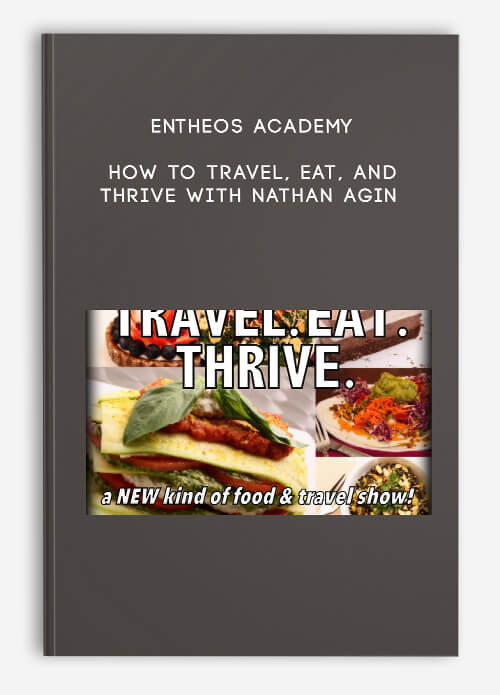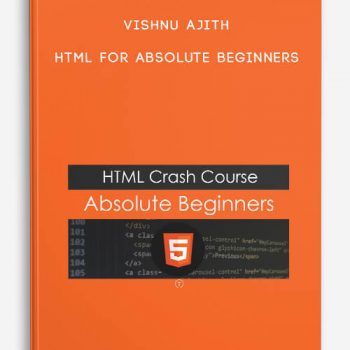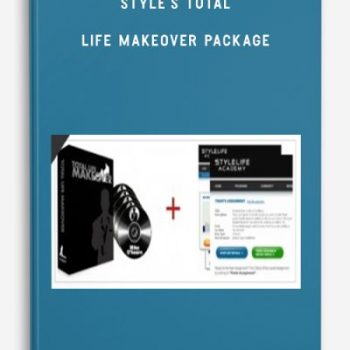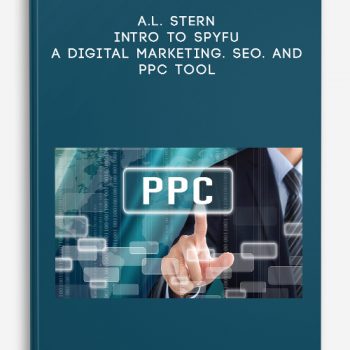
Entheos Academy – How to Travel, Eat, and Thrive with Nathan Agin
Description
Entheos Academy – How to Travel, Eat, and Thrive with Nathan Agin [WebRip – 1 MP4]
When you travel, do you know where to go for healthy and delicious food?
Most people try to be healthy when they’re at home, yet find it challenging to maintain their habits on the road.
What I’ve learned is that with a little prep and knowledge of what to look for, you can have a truly great experience with food wherever you are! Of course, we won’t be able to find the same things everywhere; part of the journey is looking for what’s available, what’s good for us, and what tastes great!It’s time to help you find the HEALTHIEST food possible: real food with quality ingredients. Let’s dive in!
The Top 10 Big Ideas
1 What Do You Eat?
Whether you’re diet is plant-based, gluten-free, or wide open, here are a few things you can focus on for Optimal Nutrition: Complete proteins containing the essential amino acids: from animal products, certain grains and legumes (if combined), and unrefined plant foods Healthy fats: unsaturated (from avocado, olives, and nuts), omega-3s (from wild-caught fish and flax/hemp/chia seeds) Complex carbohydrates (from vegetables, legumes and whole grains) There are definitely some items we want to avoid, minimize, or eliminate from our lives: simple carbohydrates, overly-processed foods, and saturated, trans fats, and hydrogenated oils (these can raise total and LDL [bad] cholesterol).
2 Plan Ahead (Yes, Before the Trip)
There is no secret hidden aisle of organic food, nor is there a gluten/dairy/nut-free restaurant down an alleyway that requires a password. Those don’t exist. Too many people are making too much money by making it easy for you *not* to eat healthy. So, you need to do your best to prepare and plan for what’s out there! Identify the foods you do eat and the ones you don’t—make this clear for yourself. Whether it’s for ethical, health, or allergy reasons, having this list will actually make your life EASIER when you’re out there and faced with a multitude of choices.
3 Don’t Become a Food Hostage!
Have your own supply of food with you. You don’t want to be held hostage by what food is available because you’re hungry. Great snacks that you can bring/buy just about anywhere (even at convenience stores!), that won’t expire quickly, and can easily be stored in pockets, purses, and backpacks: Fruit: apples, pears, oranges, raisins, bananas Vegetables: carrots, celery, radishes Nuts: almonds, pecans, walnuts Protein Bars: the fewer ingredients the better; I like Clif’s Mojo Bars Mini almond or peanut butter packs: check out Artisana’s Packets
4 Drink Plenty of Water
With all the moving around while you travel, it’s easy to get dehydrated. Whether you’re flying, driving, or just walking around, have a bottle of water—or better yet, bring your own container and fill it up at restaurants. I’ve been using a Klean Kanteen for the last four years, and I love it. It’s great to have a reusable bottle of water on hand. While any bottle you use does need to be empty for airline security, once you’re past all that, you’re free to fill it up—most restaurants offer this at the soda fountain, and some airports even offer purified water!
5 Do Your Research
Here are a few guidelines that help me when I’m in a new city looking for a place to go: Online menus: check it out and see what the options are before you get there so you have a few ideas of what you might want (See Big Idea #6 for even more detail). Read reviews: I use Yelp all the time (both online and their phone app) to look for places that have high ratings and lots of reviews. Ask the locals: “Where do you go out to eat?” You might get great suggestions you won’t find in guidebooks. You could even ask vendors in farmers markets if they have any local restaurant partners who use their ingredients.
6 Know How to Read the Menu
Go for items that are grilled, broiled, steamed, or raw—these are lighter preparations that keep the food closer to it’s natural condition and usually do not use as much butter or oil. Avoid or minimize: food that is fried, sautéed, baked, or comes with creams and gravies. I’m not against these foods completely; it’s just that the sources, quality, and quantity of the ingredients might be undesirable.
7 What To Do at the Table
When you’re actually sitting down, how do you put these ideas into practice? Skip the bread and chips (empty calories that are just getting in the way of the real food!) Order water with lemon (helps digestion)—just squeezethe lemon instead of dropping it in. Ask for substitutions: wraps instead of bread, salad or fruit instead of fries In foreign countries, it might also help to learn a few key phrases in the language, such as “I’m allergic to…,” “I don’t eat…,” and “Without …. please.”
8 Enjoy More with Less
Staying healthy when you travel doesn’t mean that you avoid the local delicacies and regional cuisine—eating new and different foods is one of the biggest perks of exploring other places! Here are a few of ways you can try new items without expanding your waistline: Share larger items: instead of everyone ordering his/her own meal, split an entrée, appetizer, or dessert. Add it yourself: with both salads and main dishes, ask for any dressings, sauces, or gravies “on the side”. Check the portions: ask your server to box up half of your meal before it even comes out—that way you’re not even tempted with what’s on the plate.
9 Now, Here’s How to Indulge!
When you *do* want to go all-out and not think about calories or sugar, here is how to do it: REALLY enjoy what you’re eating! Yes, it’s totally OK to treat yourself with something you don’t normally eat—as long as you are not beating yourself up with every bite. If the majority of the time you are eating the healthy foods you want to, then by all means, live a little. Food (and life!) is to be enjoyed! Make the best choice for yourself based on what’s available. If fried foods are how you want to treat yourself, see if you can find a place using higher-quality oils, or perhaps offering a gluten-free coating. If chocolate is your thing, look for items using a high concentration (70% or more) of cacao and natural sweeteners (such as honey and dates).
10 Are You Stressed or Relaxed?
One of my favorite bits of wisdom from author Marc David is that our body has two states: being stressed or being relaxed. That’s it. We are either one or the other. So, when we eat, we’re either going to be engaging the stress response or the relaxation response. Which one sounds better? (Not to mention, better for digestion…) Yes, relaxation! Now HOW do we engage this response? Be present with your food and with the people around you; actually look at what you’re eating and at others—make conversation. Make time to eat—plan it into your day. Taste everything by chewing slowly and breathing—lots of mastication (chewing)! This also triggers the brain and stomach to prepare for digestion.
Preview Information:
Original Page
Archive Page
Entheos Academy – How to Travel, Eat, and Thrive with Nathan Agin Available now at Coursecui.com
Entheos Academy – How to Travel, Eat, and Thrive with Nathan Agin Download, Entheos Academy – How to Travel, Eat, and Thrive with Nathan Agin Available Now, Entheos Academy – How to Travel, Eat, and Thrive with Nathan Agin Order, Entheos Academy – How to Travel, Eat, and Thrive with Nathan Agin Reviews, Entheos Academy – How to Travel, Eat, and Thrive with Nathan Agin Torrent, Entheos Academy – How to Travel, Eat, and Thrive with Nathan Agin Course Download, Entheos Academy – How to Travel, Eat, and Thrive with Nathan Agin ClubBuy, Entheos Academy – How to Travel, Eat, and Thrive with Nathan Agin Groupbuy
More Course:EVERYTHING ELSE
Outstanding Course:Spitfire Audio – Hans Zimmer Piano (Kontakt)













Lord –
This is Digital Download service, the course is available at Coursecui.com and Email download delivery.